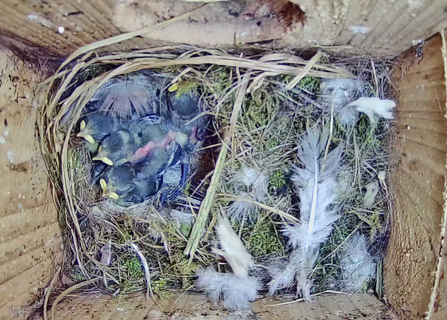1. Getting to Know the Neighbours
In the beginning
It was the birds that began it. When I look back on my progress from ignorant townie via interested artist to volunteer wildlife surveyor and general nature addict, I blame the birds for kicking off the whole thing.
I was brought up in a town and continued to live in towns until 2007. Up to that point, my contact with nature was mainly at second-hand – books, TV, David Attenborough, Gerald Durrell. Then I accidentally moved to the countryside, and suddenly nature was on my doorstep. Literally, in the case of the half-stunned bluetit left there by my attention-deficit cat. I could recognise the bluetit, but not most of the other birds that colonised the trees in the drive, fluttered over my head when I opened the door and were generally around any time I was in the garden. Hopefully, I hung out feeders, and that first year, they came in their dozens. I began to want to know more about them – they were my neighbours, after all.
The slippery slope
Wildlife addiction creeps up on you slowly. First you look, but don’t identify. Then you start asking questions, wanting to name names. Then you buy field guides and people give you binoculars and camera nestboxes for birthdays. You join the Wildlife Trust and go on courses. It’s all downhill from there. Birds seem harmless enough, but then you succumb to the easy charm of butterflies and small mammals and before you know it you’re hooked on the heavy stuff – moths, beetles, reptiles… (But not flies. Never flies. Well, not yet.) If you don’t pull back at this point, you risk getting involved in making new addicts…
A place person
A GWT staffer once asked me ‘What’s your thing?’ I was puzzled. Later I realised that he meant, what was my species fixation? Was I a bird brain, a mammal mogul or an insect inveterate? A beetle botherer? That’s not how it works for me. I am a place person. I fell in love with my local wildlife because it was there, living beside me, and what continues to drive my wildlife passion is encounters with the creatures who share my house, garden and valley. I love to see wildlife wherever I go, but my neighbours are the ones I want to know about.
Titmice trouble
I can now identify the titmice (as my mother delightfully calls them), but the camera nestbox is more important to me than the field guide. Seeing them getting on with their lives, just being themselves, fills me with wonder. And who wouldn’t root for baby bluetits? My two nestboxes were a lifeline in the early part of lockdown. As for many other people, seeing the rest of the natural world getting on with life normally was a huge reassurance. But as someone said, if you love anything, you lay yourself open to heartbreak. For the first time, both ‘my’ nests – one bluetit, one great tit – failed this year. The great tit mother inexplicably abandoned her newly hatched chicks and the blue tit parents disappeared when their six chicks were close to fledging, but not close enough. Seeing them die was devastating. What happened? I don’t know. But I know that on Springwatch Chris Packham said that climate change meant that caterpillars were arriving several days earlier on average, potentially putting bluetits out of synch with their food source. So titmouse tragedy may happen more often from now on.
Buzzard love
My erratic progress towards greater knowledge is driven by all the questions I can’t answer. As I write, a buzzard is crying continuously from her lookout point on the electricity wires nearby, and has been doing that, off and on, for weeks now. Why? I don’t know. I’m going to have to look it up, or ask an expert. Then I’ll probably have to look it up again next year. But after that, I may remember.
I read ‘A Kestrel for a Knave’ as a teenager and dreamed of keeping a falcon in our garden shed, but my mother refused planning permission. I still have a romantic attachment to raptors and especially to buzzards, the most visible raptor in this valley. Last year I accidentally spotted a nesting buzzard in trees nearby. (Accident plays a big part in my wildlife experience.) I watched the nest for some weeks but then the birds disappeared. What happened? I had to go and google buzzard lifestyles to confirm that the nest probably failed, that a big proportion of buzzard nests do. Sometimes because people shoot them.
My neighbours, my problem?
We humans do like to assign ‘hero’ and ‘villain’ roles to other creatures and treat them accordingly, as if their only importance lies in how they impact on us. Which in my view is one of many reasons we and the planet are now in a bit of a mess. But my point here is that I learned about buzzards because I worried about ‘my’ buzzards. Humans have the capacity to look beyond ourselves and empathise with other species. If more of us were enabled to do that, maybe we could dig ourselves out of our mess. We need more nature addicts. My feeling is that if we get people close to nature, nature will do the rest. How we achieve that, without overwhelming or damaging the nature we still have, is the tricky bit.


